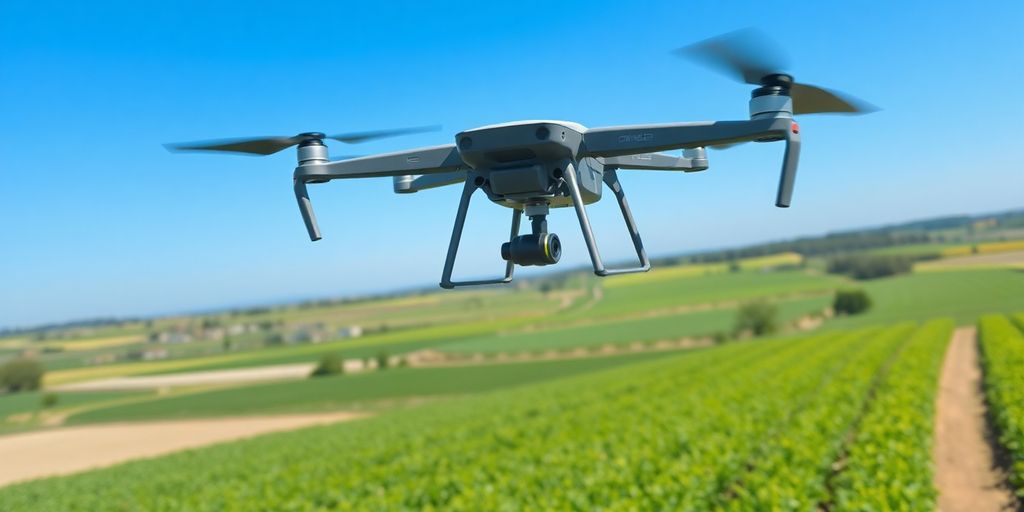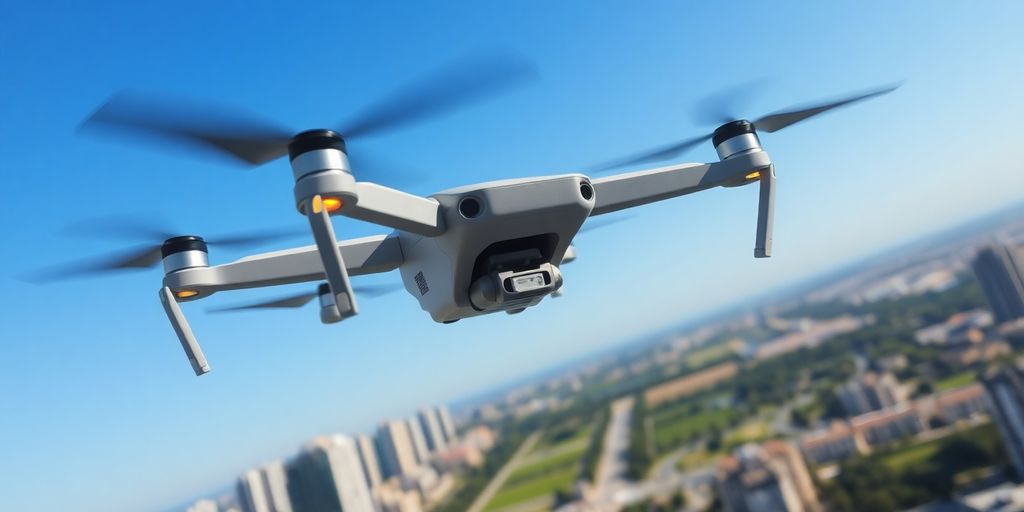What are the drone efficiency and industry trends
Drones are changing the way we think about efficiency in many industries, from agriculture to logistics. As technology moves fast, new trends and new drone capabilities are emerging to change how drones work and deliver many services. This article will look at the key trends shaping the future of drones and the innovations and strategies making them more efficient and effective across many applications.
Key Takeaways
-
Autonomous systems are making drones safer and more efficient.
-
Increased payload capacity means drones can carry bigger packages for delivery.
-
AI and machine learning are simplifying drone operations and navigation.
-
Regulatory hurdles still need to be addressed to allow wider drone use.
-
Drones are changing agriculture by making precise farming possible.
Drone Industry Overview
The drone industry has grown rapidly in recent years with the fast pace of drone technology and the surge in demand for commercial drones across many sectors. The global commercial drone market is on the up, with breakdowns by revenue growth, product types (fixed wing and rotary blade), applications (filming, agriculture, law enforcement) and regional insights that show big growth ahead. The Federal Aviation Administration (FAA) is the body that regulates drone operations and public safety.
Autonomous Communication Systems in Unmanned Aerial Vehicles
More Efficient Operations
autonomous systems are changing how autonomous drones work. These systems allow drones to work with less human input, making them faster and more efficient. Using technology, drones can find the best route and adapt quickly to new situations. They can get the job done.
Safer and More Reliable
With autonomous systems drones can also be safer. They can avoid obstacles and make decisions on their own, reducing the risk of accidents. Here’s what you get:
-
Less human intervention: Drones can work without constant human input.
-
Real time adjustments: They can change their plans based on what they see around them.
-
Consistent performance: Drones can get the job done even in harsh conditions.
Case Study: Sherpa Drone by Lucid Bots
The Sherpa Drone by Lucid Bots exemplifies how modern drones can effectively leverage autonomous systems in a range of applications. This rotary-wing drone is designed for seamless vertical take-offs and landings, ideal for navigating tight, confined spaces and urban environments. Powered by advanced AI, the Sherpa Drone independently maneuvers through complex areas without human guidance, making it an asset for building inspections, search and rescue missions, and emergency response.
The Sherpa Drone’s robust autonomous communication systems enhance its reliability and operational efficiency, setting a new standard for what drones can achieve. As drone technology progresses, the integration of autonomous systems like those in the Sherpa Drone will be essential for unlocking the full potential of drones in various industries.
Drone Payload Capacity Innovations
Bigger Payload for Bigger Deliveries
drones are capable of carrying more weight than ever before. This increased payload means bigger packages, making drone services more useful. Companies can now transport items that were too heavy for drones before, expanding their delivery options. This increased payload is a big part of the drone delivery growth.
Drone Swarms for Urban Deliveries
One of the cool things is drone swarms. This is multiple drones working together to deliver packages in urban areas. By flying in sync, they can cover more ground and reduce delivery times.
Drone Design Improvements
Drone design is also getting better. Here’s what:
-
Stronger materials to carry more weight.
-
Better batteries for longer flight time.
-
Advanced navigation systems to avoid obstacles.
As technology gets better we’ll see even more cool solutions to increase payload and efficiency.
AI and Machine Learning in Drone Operations
AI for Operations
Artificial intelligence in drone operations is a game changer. Drones can now make decisions on their own, which means they can:
-
Fly in tricky areas without help.
-
Adapt to new situations.
-
Analyze data from their sensors to get better at their job.
Collision Avoidance and Navigation
AI helps drones avoid crashes and find the best way to their destination. With advanced algorithms drones can:
-
See obstacles in their path.
-
Calculate the best route.
-
Change their flight path in real time if needed.
Real Time Decision Making by AI
Drones with AI can process information in real time. So they can:
-
Make decisions based on current data.
-
Get better during flight.
-
Adapt to weather or other conditions.
AI and drones is not just about technology, it’s about creating more intelligent systems that can get complex jobs done.
Drone Technology Challenges

Despite the exciting possibilities that drone technologies offer, there are significant challenges that need to be addressed before drones can be widely used for deliveries and other services.
Regulatory Barriers
One of the biggest hurdles is the regulatory environment. Many laws restrict where and how drones can fly. For example, in most places drones can’t fly higher than 400 feet. To make drone deliveries common, these laws will have to change which can be a long process. These regulatory barriers will impact the global drone market size.
Technical Challenges
Drones are getting better but there’s still work to be done. Here are some areas to improve:
-
Payload Capacity: Drones need to carry more weight for bigger packages.
-
Flight Time: Longer battery life for longer distances.
-
Design: Better design for better performance and reliability.
Security and Privacy
People are also concerned about drone deliveries. Concerns are:
-
Package Theft: Drones will be targets.
-
Equipment Damage: Drones will get damaged during delivery.
-
Public Trust: Many consumers won’t trust drones for their deliveries.
Solving these challenges is key to the future of drone technology. Without solving these problems the full potential of drones won’t be realized.
Drones in Agriculture

Drones are changing farming, making it easier and faster. These flying machines help farmers monitor their crops and fields.
Precision Agriculture and Crop Monitoring
-
Drones can take field photos.
-
They can see where plants need water or nutrients.
-
This allows for targeted applications, saving time and resources.
Automated Planting and Spraying
-
Drones can plant seeds fast over large areas.
-
They can spray fertilizers and pesticides evenly, no waste.
-
This automation makes farmers work faster and less.
Overcoming Regulatory Barriers
As drones become more common in farming, we need to address the rules and regulations. Farmers need support to use this technology. Regulatory support is also key for other use cases like search and rescue where drones play a critical role in disaster management by providing real time data and visual insights from areas that are hard to reach.
In short, drones are not just tools; they are changing agriculture by making it more efficient and productive. With the right support they can ensure a sustainable future for farming.
Automated Logistics with Drones
Current State of Automated Logistics
Logistics is changing fast. Drones are part of how goods are being delivered. Amazon and Walmart are already using drones to speed up deliveries. This is driven by the need for faster service in our on-demand world.
Drone Delivery Technology
Several new technologies are enabling commercial drone delivery, driving the commercial drone market:
-
Better batteries for longer flight.
-
Advanced sensors for navigation and obstacle avoidance.
-
AI for route planning.
These are key to making drone delivery a viable option.
Market and Industry
Drone delivery will have a positive impact on the logistics market. Here’s what to expect:
-
Faster delivery to meet customer needs.
-
Lower costs for businesses as drones can reduce delivery trucks and drivers.
-
Access to areas that are hard to reach by traditional delivery.
The future of logistics with drones looks good but challenges remain. As we move forward it’s clear drones will be part of how we get our goods. But there’s still work to be done, regulations and public trust.
Public Trust and Regulatory Support for Drones

Advocacy for Common Sense Regulations
To ensure safe drone use we need to advocate for common sense regulations that:
-
Promote safety in drone operations.
-
Foster innovation in drone technology.
-
Address public concerns on privacy and security.
Drone manufacturers need to support research and development to meet regulatory requirements.
Public Perception and Privacy
Public trust is key to mass adoption of drones. Many people worry about how drones will invade their privacy. To build trust we need to:
-
Educate the public on the benefits of drones.
-
Address privacy through transparent policies.
-
Engage with communities on drone use.
Drone Advocacy Alliance
The Drone Advocacy Alliance (DAA) is key to the future of drone technology. By:
-
Bringing together drone industry stakeholders.
-
Advocating for clear and fair regulations.
-
Supporting research and development.
DAA is not just about regulations; it’s about creating a safe and innovative space for drones to grow. Public trust is part of that.
Conclusion
In short the future of drones looks good and exciting. As technology advances drones are getting smarter and more efficient. They can now operate on their own, make decisions and navigate tough environments with minimal human intervention. They can do their job faster and safer. With drone swarms and better comms the way we use drones in farming and delivery is getting better. Businesses need to keep up to get the most out of drones. By embracing these trends we can look forward to a world where drones are part of our daily lives.
Frequently Asked Questions
What are autonomous comms in drones?
Autonomous comms allow unmanned aerial vehicles (UAVs) to talk to their environment with minimal human intervention. They make drones safer and more efficient by allowing them to navigate tough environments on their own.
How do drones improve delivery?
Drones can carry heavier payloads and work in swarms to deliver in busy cities. They can handle bigger deliveries than before.
What’s the role of AI in drones?
AI helps drones make decisions while flying, like avoiding obstacles and finding the best route. It makes drone ops smoother and safer.
What are the challenges for drone tech?
Drones face challenges like where they can fly, how much weight they can carry and safety and privacy concerns.
How are drones changing farming?
Drones are used in farming to monitor crop health, water plants and even plant seeds. It saves farmers time and resources while growing more food.
What is the future of drones in logistics?
The future looks bright for drones in delivery services. As technology improves, drones can deliver items faster and more efficiently, helping to solve current supply chain problems.


